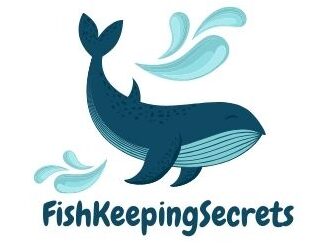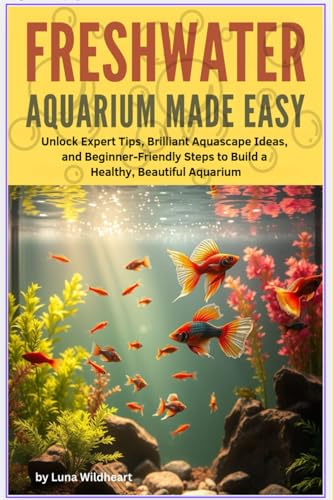10 Best Aquariums For Beginners [2025]
This post contains affiliate links. As an Amazon Associate, we earn from qualifying purchases.
Finding the best aquariums for beginners can be a daunting task, especially with the myriad of options available on the market today. Navigating through various sizes, types, and features can lead to confusion and frustration if done alone. To ease this process, we meticulously shortlisted 10 top products based on factors like ease of setup, maintenance requirements, and overall value. Our curated list not only highlights the best options tailored for novice aquarists but also saves you valuable time and hassle in making the right choice for your aquatic adventure.
Top 10 Aquariums For Beginners In The Market
Aquariums For Beginners Review
- Used Book in Good Condition
- Thraves, Stuart (Author)
- English (Publication Language)
- 96 Pages - 08/01/2007 (Publication Date) - CompanionHouse Books (Publisher)
- Munson, George (Author)
- English (Publication Language)
- 66 Pages - 10/26/2024 (Publication Date) - Independently published (Publisher)
- Wildheart, Luna (Author)
- English (Publication Language)
- 104 Pages - 07/20/2025 (Publication Date) - Independently published (Publisher)
- Jennings, Greg (Author)
- English (Publication Language)
- 528 Pages - 06/01/2018 (Publication Date) - Firefly Books (Publisher)
- James, Walter (Author)
- English (Publication Language)
- 126 Pages - 02/02/2021 (Publication Date) - Admore Publishing (Publisher)
- Jamieson, Oliver (Author)
- English (Publication Language)
- 236 Pages - 09/01/2025 (Publication Date) - Acre Press (Publisher)
- Silver, Andrew (Author)
- English (Publication Language)
- 236 Pages - 07/25/2025 (Publication Date) - LP Media Inc (Publisher)
- Hardcover Book
- Farmer, George (Author)
- English (Publication Language)
- 200 Pages - 11/10/2020 (Publication Date) - Skyhorse (Publisher)
- Skomal, Gregory (Author)
- English (Publication Language)
- 352 Pages - 11/19/2019 (Publication Date) - For Dummies (Publisher)
Our Review Process
To ensure you get reliable product recommendations, we follow a detailed review methodology that includes:
- Market Research: Scanning best-selling and trending products in this category.
- User Feedback: Reviewing customer reviews, star ratings, and complaints.
- Hands-On Testing: Trying select products ourselves when feasible.
- Feature Comparison: Evaluating specs, durability, pricing, and safety.
- Expert Opinions: Consulting with niche experts or credible reviewers.
We independently select the top 10 options based on value, quality, and usability. To learn more, visit our detailed review process.
Key Considerations Before Buying an Aquarium for Beginners
Starting an aquarium can be a rewarding hobby, but it’s important to consider several factors before making your purchase. Here are some key considerations that will help ensure your experience is enjoyable and successful.
1. Size of the Aquarium
The size of the aquarium is one of the most critical decisions you’ll make. Larger tanks generally provide a more stable environment for fish, as they can better absorb changes in water quality and temperature. However, larger tanks also require more maintenance and investment in equipment. For beginners, a tank between 20 to 40 gallons is often recommended, striking a balance between manageable size and stability.
2. Type of Fish
Different fish species have varying requirements in terms of tank size, water conditions, and compatibility with other fish. Researching the types of fish you want to keep will help guide your aquarium size and setup. Consider starting with hardy species that are known to be easier for beginners, such as guppies, neon tetras, or goldfish.
3. Freshwater vs. Saltwater
Decide whether you want a freshwater or saltwater aquarium. Freshwater tanks are generally easier to maintain, less expensive to set up, and offer a wider variety of beginner-friendly fish. Saltwater tanks, while stunning, require more equipment and a higher level of commitment due to their complex ecosystem and water chemistry management.
4. Equipment and Accessories
Ensure you have the necessary equipment for your aquarium, including a filtration system, heater (if keeping tropical fish), lighting, and substrate. Research the best options for your chosen tank size and type of fish. Accessories like plants, rocks, and decorations can enhance the aesthetic of your aquarium, but they should also be safe and suitable for the fish you plan to keep.
5. Budget
Establish a budget not only for the aquarium itself but also for ongoing expenses such as food, water conditioners, and equipment maintenance. Remember that larger tanks and saltwater setups tend to be more expensive. Be prepared for initial costs and ongoing maintenance to keep your aquarium thriving.
6. Maintenance Requirements
All aquariums require regular maintenance, including water changes, filter cleaning, and monitoring water quality. Consider how much time and effort you can realistically devote to maintaining your aquarium. Some tanks may require more frequent attention than others, depending on the size and number of fish.
7. Location
Choose a suitable location for your aquarium that provides stability and accessibility. The surface should be level and strong enough to support the weight of the tank when filled with water. Avoid placing the aquarium in direct sunlight, as this can lead to unwanted algae growth and temperature fluctuations.
8. Cycle the Aquarium
Before adding fish, it’s essential to cycle your aquarium to establish beneficial bacteria that help break down waste. This process can take several weeks, and it’s crucial for maintaining a healthy environment for your fish. Familiarize yourself with the nitrogen cycle and how to test water parameters to ensure a successful cycling process.
9. Community and Support
Engage with local or online aquarium communities for support and advice. Many beginners benefit from the experiences of seasoned hobbyists who can offer tips on fish selection, maintenance, and troubleshooting common issues. Local fish stores can also provide valuable resources and information.
10. Commitment Level
Lastly, consider your level of commitment to the hobby. Keeping an aquarium requires dedication, time, and effort. Make sure you are ready for the responsibilities that come with caring for living creatures. If you find that you’re not fully committed, it may be wise to reconsider before diving in.
FAQs
What size aquarium should I start with as a beginner?
For beginners, a 20 to 30-gallon aquarium is often recommended. This size is manageable while also providing enough water volume to help maintain stable water parameters. Smaller tanks can be more challenging to keep balanced, especially for beginners.
What equipment do I need for a beginner aquarium?
To set up your aquarium, you’ll need a filter, heater (if keeping tropical fish), substrate (gravel or sand), decorations, and water conditioner. Additionally, a test kit for monitoring water parameters (like pH, ammonia, nitrites, and nitrates) is important.
How do I cycle my aquarium?
Cycling your aquarium means establishing beneficial bacteria that convert harmful waste into less harmful substances. You can cycle your tank using the fishless method (adding ammonia) or by using fish (which is less recommended for beginners). A typical cycle takes 4 to 6 weeks, during which you should monitor water parameters regularly.
What types of fish are best for beginners?
Some beginner-friendly fish include guppies, neon tetras, zebrafish, and bettas. These species are generally hardy and adapt well to varying conditions, making them ideal for new aquarists. Always research compatibility and tank conditions before adding fish to your aquarium.
How often should I feed my fish?
Feed your fish small amounts once or twice a day, only what they can consume in a few minutes. Overfeeding can lead to water quality issues, so it’s better to err on the side of caution. Make sure to remove any uneaten food to keep the tank clean.
How often should I perform water changes?
Regular water changes are essential for maintaining a healthy aquarium. As a beginner, aim for a 10-15% water change weekly. This will help remove toxins and replenish essential minerals. More frequent changes may be needed if your tank is heavily stocked or if you notice water quality issues.
What should I do if my fish are acting strangely?
If your fish show signs of distress, such as unusual swimming patterns, hiding, or rapid gill movement, check your water parameters immediately. Poor water quality, disease, or stress can cause these behaviors. Address any issues promptly, and consider consulting a knowledgeable aquarist or local aquarium store for advice.
Can I keep live plants in my aquarium?
Yes, live plants are a great addition to beginner aquariums! They help improve water quality by absorbing nitrates and provide shelter and hiding spots for fish. Choose easy-care plants like Java fern, Anubias, or Amazon sword to start with.
How do I maintain water quality in my aquarium?
To maintain water quality, regularly check water parameters, perform routine water changes, and keep the filter clean. Avoid overfeeding your fish and remove uneaten food and debris promptly. Additionally, consider using a good quality water conditioner to treat tap water before adding it to the tank.
What should I know about aquarium lighting?
Aquarium lighting is crucial for both fish and plants. Use an appropriate light source based on your tank’s needs. For planted tanks, aim for around 8 to 10 hours of light per day. Ensure the light is not too intense to prevent algae growth and fish stress.
The Bottom Line
In conclusion, choosing the right aquarium as a beginner is crucial for setting the foundation of a successful and enjoyable fishkeeping experience. Our curated list of the 10 best aquariums for beginners was carefully selected based on several key factors, including ease of setup, maintenance requirements, size options, and user reviews. We considered a variety of styles and budgets to ensure that novice aquarists can find the perfect match for their needs and preferences. Each product on our list offers unique features that cater specifically to beginners, making the process of starting an aquarium less daunting and more accessible.
By following our list, users can confidently embark on their fishkeeping journey, knowing they have chosen proven products that will help them create a thriving aquatic environment. Whether you are looking for a small tank for your desk or a larger setup for a more diverse community of fish, our recommendations encompass a range of options designed to facilitate a smooth start. With the right aquarium in place, you can focus on enjoying the mesmerizing world of aquatic life and developing your skills as a responsible fishkeeper.









